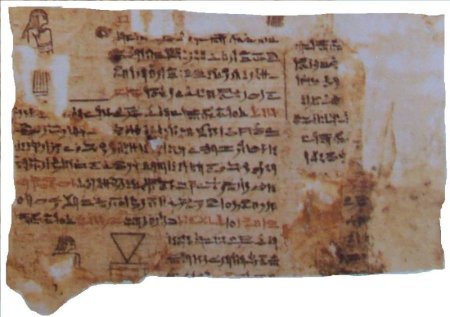Joseph Smith Papyri
In July of 1835 a man named Michael Chandler came to Kirtland, Ohio, with a display of Egyptian mummies and writings, which had been found in Thebes, Egypt, fifteen years earlier. Joseph Smith purchased four of the mummies and some papyri. Joseph began to attempt to translate the texts. He said, "Much to our joy [we] found that one of the rolls contained the writings of Abraham." He translated this portion, which is now part of Mormon scripture -- the Book of Abraham in the Pearl of Great Price.
There is little historical data about what happened to the papyri after Joseph translated this portion. Recently, a Brigham Young University professor has been trying to unravel this history. Kerry Muhlestein is an Associate Professor of Ancient Scripture and Ancient Near Eastern Studies at BYU.
Unfortunately, the majority of the papyri, which were eventually displayed in Chicago’s Wood Museum, was destroyed in the Great Chicago Fire of 1871. For nearly a century, it was believed all the papyri were lost. But in 1967, New York’s Metropolitan Museum of Art presented the Church with 11 papyri fragments that Joseph Smith had owned. These fragments are known today as the Joseph Smith Papyri.
Muhlestein and his student research assistant have been putting in chronological order the first-hand accounts from people who saw the fragments, and also second-hand accounts. By the winter of 2009, they had found around 60 personal accounts. Muhlestein, who is also assistant director of the BYU Egypt Excavation Project, has dedicated years to the study of the Book of Abraham. He hopes that through his research he can provide greater understanding and answer questions that people, including critics, may have about it.
- “Critics of the Church insist that the text adjacent to Facsimile 1 [present in the published Book of Abraham, and one the remaining fragments] is the source of Book of Abraham, but when translated, it reads as an Egyptian funerary document,” he said. “They say this proves that Joseph Smith did not possess the ability to translate ancient documents, putting into question the validity of the Book of Mormon. By determining how early these fragments were separated from the papyri, we can prove that they are not the source of the Book of Abraham. It seems that Joseph Smith cut off the fragment with Facsimile 1 himself.”
Muhlestein, an Egyptologist, argues that in many ancient papyri, pictures and text were often separated from each other. In addition, he theorizes that at least some of these surviving fragments came from the frayed ends of the outside wrap of a papyrus scroll. “These ends were likely cut off and put under glass to protect them,” he said.
“This research is helping us understand how much of the papyri Joseph Smith translated, when he was translating, the process he went through as he was trying to publish it, and what he and other members of the Church thought were on the papyri,” Muhlestein continued. “The research isn’t done yet, but there are some interesting things coming out already. For instance, the assumption has [previously] been that the things Oliver Cowdery described in the papyri were from the fragments we have today. However, it seems he’s describing papyri that were lost.”
Muhlestein said today’s papyri fragments were once glued to pieces of paper, which his colleagues who specialize in the Ohio and Missouri Church history periods believe come from the Ohio period. He says this is significant because he has been able to identify eyewitnesses from the later Nauvoo period who describe the fragments we have today as already being cut off and mounted under glass when they saw them. A year after these accounts, there are sources who say that Joseph Smith and his mother are still identifying a large roll of papyrus, different from the fragments Joseph had cut and preserved, as the source of the Book of Abraham.
“What that means is that we have eyewitnesses who confirm that the fragments we have are not the source of the Book of Abraham. Our critics are flying in the face of these witnesses.”
Muhlestein and Nordstrom have been working on this project for about a year and a half. They hope to be finished by June 2010, at which time Muhlestein will begin writing the book that reveals their findings.
Muhlestein’s project is sponsored by the Susan Easton Black Endowment for Mentored Student Research on the Life and Teachings of Joseph Smith (LDS Living 2009).
